It looks like you're using an Ad Blocker.
Please white-list or disable AboveTopSecret.com in your ad-blocking tool.
Thank you.
Some features of ATS will be disabled while you continue to use an ad-blocker.
6
share:
My OP in a nutshell: A prophecy written over a millennium ago has predicted the Cultural Revolution, and possibly the reunification of China and
China's rise to superpower status.
This is the second of a two-part series regarding the 'back-pushing pictures'. The last part can be found here: www.abovetopsecret.com... Please read that thread before doubting the accuracy or authenticity of the Tui Bei Tu. Thanks.
The reason why I put this in Prophecies? Well, this one is more about our future than our past. (Besides, I don't want to look like I'm spamming the ancient civilisations forum...)
For convenience, I'll divide this thread into several parts. The first two posts of the last instalment are the first two parts, so we'll start with the third part.
Part Three:The Cultural Revolution and Subsequent Reforms
Last time, we left off at Picture 40, the one with three little kids. Let's start again with Picture 41.
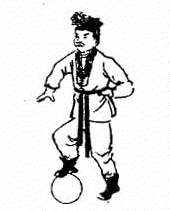
This picture is controversial, mainly because it's uncontroversial. The Mainland conspiracy group refused to analyse it themselves, citing 'various reasons' for the reader to 'imagine' the meaning him/herself. In fact, this picture could be the very reason why Mao Zedong banned the TBT. What the heck, I'll go ahead and analyse.
Let's start with the first poem (the picture will be obvious once we get to the second poem):
The sky and the earth are dark and blind.
The grass and the wood are reproducing rapidly.
The yin and the yang are reversed.
The soil on top, the sun on the bottom.
There are two things we can see from the poem. The first thing is complete and utter destruction. The plants reproducing rapidly is not a good sign; rather, it signifies the lack of human activities, as with a house covered with ivy. (It could be a reference to the three difficult years before the Cultural Revolution, when millions died.) The second thing is that everything is reversed. The earth is above the sky. The yin and yang are reversed. Good is evil, and evil is good. The ten only years that fit this description - the Cultural Revolution, when every man on Chinese soil (except for Taiwan, Hong Kong and Macau) lived in constant fear. Destruction of all things 'old' - that was the premise of the Revolution, and yet, it ended up destroying culture itself.
If you're Chinese, it may be hard to accept that Chairman Mao was criticised by a Tang prophet, but let's face it - it's not like Mao's era was heaven on Earth. Our respected leader was only human, and there's a limit to which a human can do.
The second poem:
The hat has to be worn, but the blood has no head.
The hand is messing up the sky and the earth; when will it stop?
On the ninety-ninth year, a serious error was created.
You're only fit to call yourself a king in Qinzhou.
(Sorry about the bad translation. Not everything can be translated literally without sounding like a madman.)
The first line is a fairly obvious reference to the Mao's practice of making 'rightists' wear hats. The second one is an obvious allusion to Chairman Mao. (Now it should be obvious what the picture is talking about.)
The next two may be more interesting. The Chinese word for 'ninety-nine' is 'jiushijiu', in which 'jiu' means 'nine' and 'shi' means 'ten'. 9+10+9 = 28. Mao Zedong passed away 28 years after the establishment of the PRC.
The last line is also quite obvious if you know where Qinzhou is. Qinzhou is an old name for Xi'an. Remember the Xi'an incident? The TBT was saying that Mao should have stayed in Xi'an instead of ruling over the whole of China.
On to something somewhat happier. Picture 42:
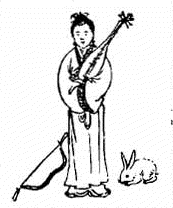
There are two theories as to the meaning of this picture. Both are best explained as a whole. I'll try to explain both here as best I can.
According to the first interpretation, this woman is Jiang Qing, Mao's wife. Jiang Qing has a notorious reputation as one of the Gang of Four and is widely condemned in China. She really did 'come from the west' as the poem says as Mao Zedong married her at Yan'an, Western China.
The three objects are quite obvious if you look at the characters carefully. :
-The long bow refers to Zhang Chunqiao - the Chinese character 'Zhang' - 張 contains both the character for 'long', 長, and the character for 'bow', 弓.
-The rabbit refers to Yao Wenyuan - rabbits hop, and the Chinese character for 'hop' is 跳, which looks like the Chinese character 'Yao' 姚. If you remove the left component from 跳 'hop' and replace it with the 'female' radical (which corresponds to the woman in the middle), you get 姚 Yao.
-The pipa refers to Wang Hongwen - the Chinese character 王 appears in the Chinese characters for pipa (琵琶) four times
All this makes a lot of sense, but there's an alternative explanation that will make later pictures more understandable. In fact, it could well be that the prophet(s) meant both.
The second explanation is that the woman is the US. The Chinese name for the US is 美國 Meiguo, and the Chinese word for 'beautiful woman' is 美人 meiren. The US is a Western country, so it the 'comes from the west' bit should be a no-brainer. The second half of the second poem is clearly referring to the CIA, which has countless spies in China.
Although this interpretation is not as convincing as the Jiang Qing one, we'll see its importance in a couple of pictures.
This is the second of a two-part series regarding the 'back-pushing pictures'. The last part can be found here: www.abovetopsecret.com... Please read that thread before doubting the accuracy or authenticity of the Tui Bei Tu. Thanks.
The reason why I put this in Prophecies? Well, this one is more about our future than our past. (Besides, I don't want to look like I'm spamming the ancient civilisations forum...)
For convenience, I'll divide this thread into several parts. The first two posts of the last instalment are the first two parts, so we'll start with the third part.
Part Three:The Cultural Revolution and Subsequent Reforms
Last time, we left off at Picture 40, the one with three little kids. Let's start again with Picture 41.

This picture is controversial, mainly because it's uncontroversial. The Mainland conspiracy group refused to analyse it themselves, citing 'various reasons' for the reader to 'imagine' the meaning him/herself. In fact, this picture could be the very reason why Mao Zedong banned the TBT. What the heck, I'll go ahead and analyse.
Let's start with the first poem (the picture will be obvious once we get to the second poem):
天地晦盲 草木蕃殖
阴阳反背 上土下日
The sky and the earth are dark and blind.
The grass and the wood are reproducing rapidly.
The yin and the yang are reversed.
The soil on top, the sun on the bottom.
There are two things we can see from the poem. The first thing is complete and utter destruction. The plants reproducing rapidly is not a good sign; rather, it signifies the lack of human activities, as with a house covered with ivy. (It could be a reference to the three difficult years before the Cultural Revolution, when millions died.) The second thing is that everything is reversed. The earth is above the sky. The yin and yang are reversed. Good is evil, and evil is good. The ten only years that fit this description - the Cultural Revolution, when every man on Chinese soil (except for Taiwan, Hong Kong and Macau) lived in constant fear. Destruction of all things 'old' - that was the premise of the Revolution, and yet, it ended up destroying culture itself.
If you're Chinese, it may be hard to accept that Chairman Mao was criticised by a Tang prophet, but let's face it - it's not like Mao's era was heaven on Earth. Our respected leader was only human, and there's a limit to which a human can do.
The second poem:
帽兒須戴血無頭 手弄乾坤何日休
九十九年成大錯 稱王只合在秦州
The hat has to be worn, but the blood has no head.
The hand is messing up the sky and the earth; when will it stop?
On the ninety-ninth year, a serious error was created.
You're only fit to call yourself a king in Qinzhou.
(Sorry about the bad translation. Not everything can be translated literally without sounding like a madman.)
The first line is a fairly obvious reference to the Mao's practice of making 'rightists' wear hats. The second one is an obvious allusion to Chairman Mao. (Now it should be obvious what the picture is talking about.)
The next two may be more interesting. The Chinese word for 'ninety-nine' is 'jiushijiu', in which 'jiu' means 'nine' and 'shi' means 'ten'. 9+10+9 = 28. Mao Zedong passed away 28 years after the establishment of the PRC.
The last line is also quite obvious if you know where Qinzhou is. Qinzhou is an old name for Xi'an. Remember the Xi'an incident? The TBT was saying that Mao should have stayed in Xi'an instead of ruling over the whole of China.
On to something somewhat happier. Picture 42:

美人自西來 朝中日漸安
長弓在地 危而不危
'The pretty woman comes from the west.
It's starting to settle down in the court.
The long bow is on the ground.
It's dangerous, but not that dangerous.
西方女子琵琶仙 皎皎衣裳色更鮮
此時渾跡匿朝市 鬧亂君臣百萬般
Woman of the west, pipa deity.
The white clothing's colour is even brighter.
At this time, filthy stains hide in the morning market,
Screwing up, monarch and subjects, in a million ways.
There are two theories as to the meaning of this picture. Both are best explained as a whole. I'll try to explain both here as best I can.
According to the first interpretation, this woman is Jiang Qing, Mao's wife. Jiang Qing has a notorious reputation as one of the Gang of Four and is widely condemned in China. She really did 'come from the west' as the poem says as Mao Zedong married her at Yan'an, Western China.
The three objects are quite obvious if you look at the characters carefully. :
-The long bow refers to Zhang Chunqiao - the Chinese character 'Zhang' - 張 contains both the character for 'long', 長, and the character for 'bow', 弓.
-The rabbit refers to Yao Wenyuan - rabbits hop, and the Chinese character for 'hop' is 跳, which looks like the Chinese character 'Yao' 姚. If you remove the left component from 跳 'hop' and replace it with the 'female' radical (which corresponds to the woman in the middle), you get 姚 Yao.
-The pipa refers to Wang Hongwen - the Chinese character 王 appears in the Chinese characters for pipa (琵琶) four times
All this makes a lot of sense, but there's an alternative explanation that will make later pictures more understandable. In fact, it could well be that the prophet(s) meant both.
The second explanation is that the woman is the US. The Chinese name for the US is 美國 Meiguo, and the Chinese word for 'beautiful woman' is 美人 meiren. The US is a Western country, so it the 'comes from the west' bit should be a no-brainer. The second half of the second poem is clearly referring to the CIA, which has countless spies in China.
Although this interpretation is not as convincing as the Jiang Qing one, we'll see its importance in a couple of pictures.
edit on 12-2-2013 by diqiushiwojia because: (no reason given)
Part Four - China's rise and road to superpower-ship

Classical Chinese is a confusing language, so you may be completely lost right now. Let's explain the poems first, then try and see what event it's referring to.
'The monarch is not the monarch, the subjects are not the subjects' - a typical Confucian saying, and it means that the monarch does not fulfil the responsibilities of a monarch and the subjects do not fulfil the responsibilities of subjects.
'The black rabbit walks into the Azure Dragon's cave' - the first thing we need to know is that the Azure Dragon is a creature of the wood element and protects the east. The black rabbit, like all black things, should be of the water element. The relationship between the wood and water elements is creation, not destruction, so the result should be pretty constructive. I've snitched this pic from Wikipedia to illustrate this concept:
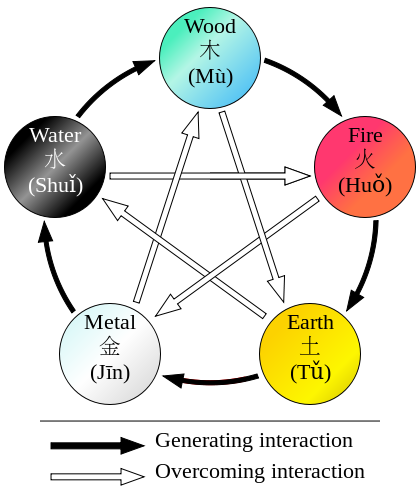
I have no idea what a root-tree is, and I can't look it up anywhere. One of the TBT analyses says it's a tree growing from the roots of another tree, so I'll go with that. What's even weirder about this is that if you extract three of the syllables from this line, 'wai bian gen', you get something that some like 'American'.
The last line is much easier - the problem is solved by the descendents 30 years later.
Let's tackle the picture and the first poem first. In the pic, Taiwan is the smaller but richer man, and the Mainland is the larger but poorer man. Their relative positions also indicate this. The larger man looks unaggressive, but also appears to be preparing to hit the smaller man. The smaller man does not look afraid, but holds up his hand to defend himself. That's the present situation, isn't it?
Now the first poem. Monarch-subject relations between countries may sound strange to Westerners, but it really happened a lot in East Asia. For example, at one point, the Jin Dynasty was 'monarch' and the Song Dynasty was 'subject'. In this context, the mainland is supposed to be the 'monarch' but isn't, and Taiwan is supposed to be the 'subject' but isn't.
The second halves of both poems indicate a resolution, which is perhaps the reunification of China. The situation is difficult at first, but resolved at last. That 'root-tree' was tied to the rest of the tree in thirty years. Thirty years after the beginning of China's economic reforms... that's right now! Remember the last picture of my last thread, where the 'eagle', Ma Yingjiu, was said to be the last ruler of the ROC?
The rabbit-meets-dragon part is the most confusing. Here are some theories on the Internet - please decide for yourself:
-The UN's embargo on China may be over, but the US (rabbit) won't let go of their strings in China (hence 'wishes to put an end...'
-Between a year of the rabbit and a year of the dragon (2000, 2012)
-The rabbit is Chen Shuibian, who was born in the year of the rabbit, and the cave = Taiwan (azure - blue - Nationalists)
Now that China's unified...
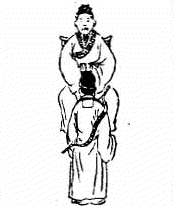
The sun and the moon make the sky beautiful
The many 'yins' (evils) surrender in awe
A hundred spirits arrive at the court
Two wings, four feet
China now has a saint
Although not a great hero, (s)he restored China to the Zhou Dynasty's glory
Four 'barbarians' translate again, and call [China] Emperor
The bad has reached its limit, the good returns, and it is spring for 'nine states'
This is a weird prophecy, but bear in mind that the TBT was really Sinocentric, and everything is from the point of view of Mainland China.
One theory is that the sun and moon may refer to Hu Jintao and Wen Jiabao. The Chinese character Hu 胡 has the Chinese character for moon 月 in it, and the Chinese character Wen 溫 has the Chinese character for sun 日 in it. (日, incidentally, was evolved from the solar symbol of a circle with a dot in the centre.) However, Hu's era is nearly over and nothing remarkable has happened, so this theory may not be correct after all.
There isn't much speculation on the yin forces, but they are probably the CIA agents mentioned above.
'Hundred spirits' is the Chinese name for the shore lark (this picture is from Wikipedia):
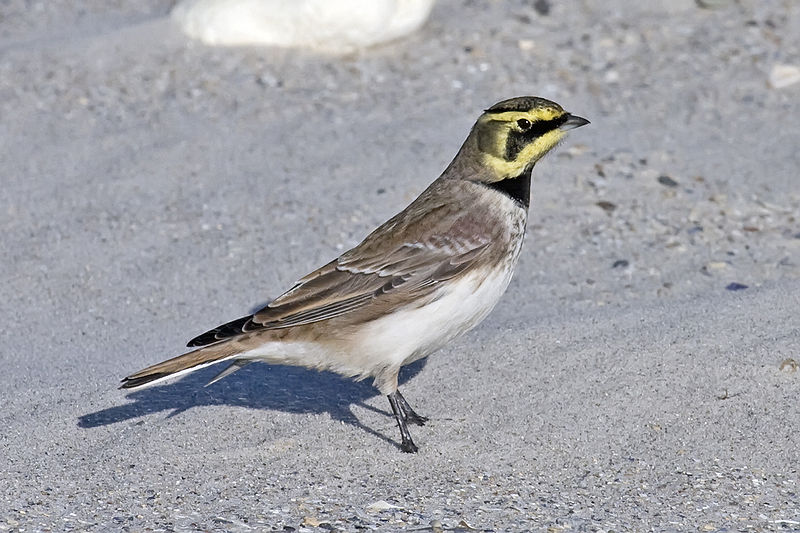
The traditional Chinese character for Xi 習 also has two wings (though not four legs). However, neither larks nor Xi have four legs. What could that line mean? Some speculate that it is the Chinese character 燕, which has two wings and four legs.
The second poem clearly states that there will be a saint in China. The 'four barbarians' is the interesting part. Traditionally, it refers to the Dongyi of the East, Nanman of the South, Xirong of the West and Beidi of the North, which are collectively known as Manyirongdi, which in turn is an umbrella term for all foreigners. (Foreigners were all 'barbarians' to the ancient Chinese. Westerners were called 'barbarians' as late as the Qing Dynasty.) If that is the case, then it could be that the US is no longer the superpower and, along with all other countries, bow down to China.
The last line is another no-brainer. All the difficulties are the past. China was divided into nine 'provinces' by Yu the Great and 'the nine provinces' has become a synonym of China. Therefore, the last line says that it's a new beginning (spring, as in Arab Spring) for China.
That's all I have to say. There are more prophecies, but decoding them will involve lots of speculation. Do you think I should try decoding those as well?

君非君 臣非臣
始艱危 終克定
The monarch is not the monarch
The subjects are not the subjects
It was difficult and dangerous at first
These were overcome at last and things settled down
黑兔走入青龍穴 欲盡不盡不可說
唯有外邊根樹上 三十年中子孫結
The black rabbits walk into the Azure Dragon's cave
Wishes to [?] everything/put and end to [?], but can't; it can't be spoken
Only outside, on the root-tree
In thirty years, the sons and grandsons tie together
Classical Chinese is a confusing language, so you may be completely lost right now. Let's explain the poems first, then try and see what event it's referring to.
'The monarch is not the monarch, the subjects are not the subjects' - a typical Confucian saying, and it means that the monarch does not fulfil the responsibilities of a monarch and the subjects do not fulfil the responsibilities of subjects.
'The black rabbit walks into the Azure Dragon's cave' - the first thing we need to know is that the Azure Dragon is a creature of the wood element and protects the east. The black rabbit, like all black things, should be of the water element. The relationship between the wood and water elements is creation, not destruction, so the result should be pretty constructive. I've snitched this pic from Wikipedia to illustrate this concept:

I have no idea what a root-tree is, and I can't look it up anywhere. One of the TBT analyses says it's a tree growing from the roots of another tree, so I'll go with that. What's even weirder about this is that if you extract three of the syllables from this line, 'wai bian gen', you get something that some like 'American'.
The last line is much easier - the problem is solved by the descendents 30 years later.
Let's tackle the picture and the first poem first. In the pic, Taiwan is the smaller but richer man, and the Mainland is the larger but poorer man. Their relative positions also indicate this. The larger man looks unaggressive, but also appears to be preparing to hit the smaller man. The smaller man does not look afraid, but holds up his hand to defend himself. That's the present situation, isn't it?
Now the first poem. Monarch-subject relations between countries may sound strange to Westerners, but it really happened a lot in East Asia. For example, at one point, the Jin Dynasty was 'monarch' and the Song Dynasty was 'subject'. In this context, the mainland is supposed to be the 'monarch' but isn't, and Taiwan is supposed to be the 'subject' but isn't.
The second halves of both poems indicate a resolution, which is perhaps the reunification of China. The situation is difficult at first, but resolved at last. That 'root-tree' was tied to the rest of the tree in thirty years. Thirty years after the beginning of China's economic reforms... that's right now! Remember the last picture of my last thread, where the 'eagle', Ma Yingjiu, was said to be the last ruler of the ROC?
The rabbit-meets-dragon part is the most confusing. Here are some theories on the Internet - please decide for yourself:
-The UN's embargo on China may be over, but the US (rabbit) won't let go of their strings in China (hence 'wishes to put an end...'
-Between a year of the rabbit and a year of the dragon (2000, 2012)
-The rabbit is Chen Shuibian, who was born in the year of the rabbit, and the cave = Taiwan (azure - blue - Nationalists)
Now that China's unified...

日月丽天 群阴慑服
百灵来朝 双羽四足
The sun and the moon make the sky beautiful
The many 'yins' (evils) surrender in awe
A hundred spirits arrive at the court
Two wings, four feet
中国而今有圣人
虽非豪杰也周成
四夷重译称天子
否极泰来九国春
China now has a saint
Although not a great hero, (s)he restored China to the Zhou Dynasty's glory
Four 'barbarians' translate again, and call [China] Emperor
The bad has reached its limit, the good returns, and it is spring for 'nine states'
This is a weird prophecy, but bear in mind that the TBT was really Sinocentric, and everything is from the point of view of Mainland China.
One theory is that the sun and moon may refer to Hu Jintao and Wen Jiabao. The Chinese character Hu 胡 has the Chinese character for moon 月 in it, and the Chinese character Wen 溫 has the Chinese character for sun 日 in it. (日, incidentally, was evolved from the solar symbol of a circle with a dot in the centre.) However, Hu's era is nearly over and nothing remarkable has happened, so this theory may not be correct after all.
There isn't much speculation on the yin forces, but they are probably the CIA agents mentioned above.
'Hundred spirits' is the Chinese name for the shore lark (this picture is from Wikipedia):

The traditional Chinese character for Xi 習 also has two wings (though not four legs). However, neither larks nor Xi have four legs. What could that line mean? Some speculate that it is the Chinese character 燕, which has two wings and four legs.
The second poem clearly states that there will be a saint in China. The 'four barbarians' is the interesting part. Traditionally, it refers to the Dongyi of the East, Nanman of the South, Xirong of the West and Beidi of the North, which are collectively known as Manyirongdi, which in turn is an umbrella term for all foreigners. (Foreigners were all 'barbarians' to the ancient Chinese. Westerners were called 'barbarians' as late as the Qing Dynasty.) If that is the case, then it could be that the US is no longer the superpower and, along with all other countries, bow down to China.
The last line is another no-brainer. All the difficulties are the past. China was divided into nine 'provinces' by Yu the Great and 'the nine provinces' has become a synonym of China. Therefore, the last line says that it's a new beginning (spring, as in Arab Spring) for China.
That's all I have to say. There are more prophecies, but decoding them will involve lots of speculation. Do you think I should try decoding those as well?
edit on 12-2-2013 by diqiushiwojia because: (no reason given)
edit on 12-2-2013 by diqiushiwojia because: (no reason
given)
Very interesting.
I don't know if decoding the rest is worth your time, or not. You are the best judge of that.
I certainly enjoyed reading these. . . . memories . . . of my years in China.
Thanks thanks.
I don't know if decoding the rest is worth your time, or not. You are the best judge of that.
I certainly enjoyed reading these. . . . memories . . . of my years in China.
Thanks thanks.
Maybe it's just my dirty mind, but the picture with the China unified caption, reminds me of when bill Clinton was doing some unifying in the white
house office..
Great thread op.. s n f
Great thread op.. s n f
edit on 12-2-2013 by misscurious because: (no reason given)
reply to post by BO XIAN
Thanks Bo Xian. What does the name mean in characters? I tried but couldn't make sense of it.
Thanks Bo Xian. What does the name mean in characters? I tried but couldn't make sense of it.
new topics
-
A Warning to America: 25 Ways the US is Being Destroyed
New World Order: 3 hours ago -
President BIDEN's FBI Raided Donald Trump's Florida Home for OBAMA-NORTH KOREA Documents.
Political Conspiracies: 9 hours ago -
Maestro Benedetto
Literature: 10 hours ago -
Is AI Better Than the Hollywood Elite?
Movies: 10 hours ago
top topics
-
President BIDEN's FBI Raided Donald Trump's Florida Home for OBAMA-NORTH KOREA Documents.
Political Conspiracies: 9 hours ago, 28 flags -
Gaza Terrorists Attack US Humanitarian Pier During Construction
Middle East Issues: 15 hours ago, 8 flags -
Massachusetts Drag Queen Leads Young Kids in Free Palestine Chant
Social Issues and Civil Unrest: 17 hours ago, 7 flags -
Las Vegas UFO Spotting Teen Traumatized by Demon Creature in Backyard
Aliens and UFOs: 14 hours ago, 6 flags -
A Warning to America: 25 Ways the US is Being Destroyed
New World Order: 3 hours ago, 6 flags -
Meadows, Giuliani Among 11 Indicted in Arizona in Latest 2020 Election Subversion Case
Mainstream News: 17 hours ago, 5 flags -
2024 Pigeon Forge Rod Run - On the Strip (Video made for you)
Automotive Discussion: 15 hours ago, 4 flags -
Is AI Better Than the Hollywood Elite?
Movies: 10 hours ago, 3 flags -
The functionality of boldening and italics is clunky and no post char limit warning?
ATS Freshman's Forum: 16 hours ago, 1 flags -
Maestro Benedetto
Literature: 10 hours ago, 1 flags
6
